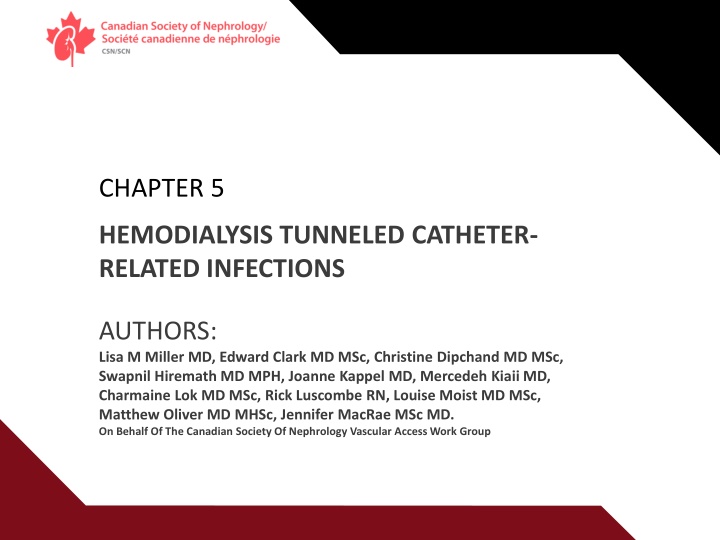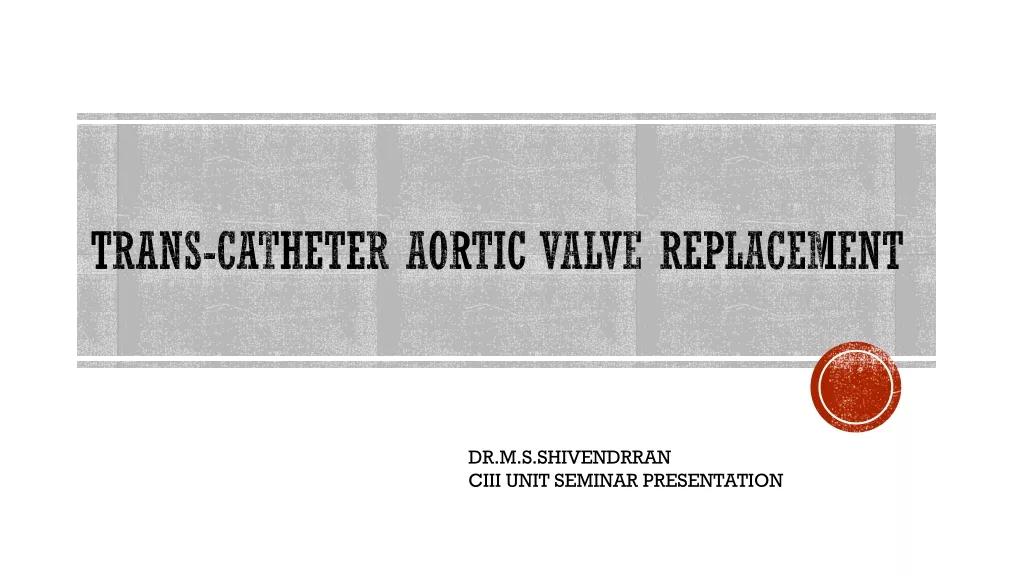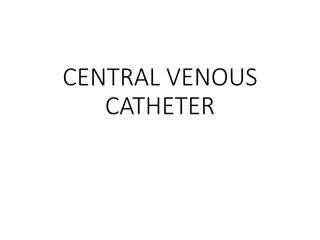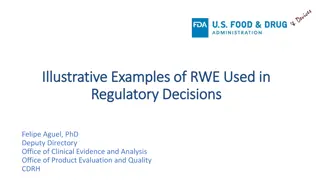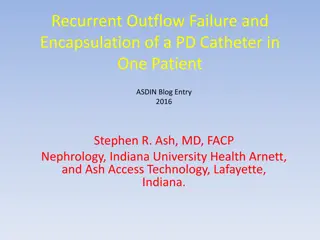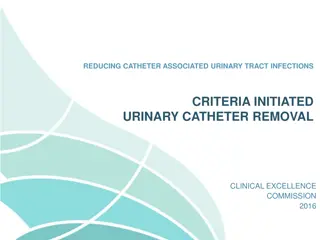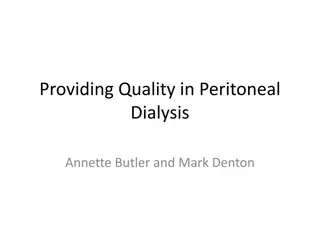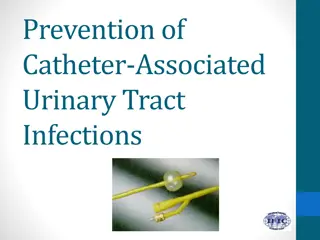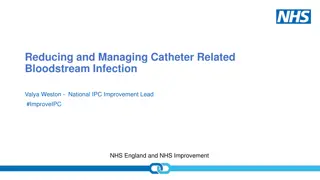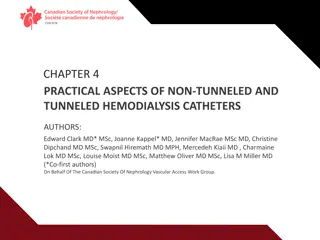Hemodialysis Tunneled Catheter-Related Infections Overview
This chapter discusses the common complications related to hemodialysis catheter use, including bloodstream infections, exit-site infections, and tunnel infections. It covers definitions, clinical features, diagnostic challenges, causative pathogens, complications, and prevention and treatment strategies for catheter-related infections.
Download Presentation

Please find below an Image/Link to download the presentation.
The content on the website is provided AS IS for your information and personal use only. It may not be sold, licensed, or shared on other websites without obtaining consent from the author.If you encounter any issues during the download, it is possible that the publisher has removed the file from their server.
You are allowed to download the files provided on this website for personal or commercial use, subject to the condition that they are used lawfully. All files are the property of their respective owners.
The content on the website is provided AS IS for your information and personal use only. It may not be sold, licensed, or shared on other websites without obtaining consent from the author.
E N D
Presentation Transcript
Vascular Access Education Initiative | 2015 CHAPTER 5 HEMODIALYSIS TUNNELED CATHETER- RELATED INFECTIONS AUTHORS: Lisa M Miller MD, Edward Clark MD MSc, Christine Dipchand MD MSc, Swapnil Hiremath MD MPH, Joanne Kappel MD, Mercedeh Kiaii MD, Charmaine Lok MD MSc, Rick Luscombe RN, Louise Moist MD MSc, Matthew Oliver MD MHSc, Jennifer MacRae MSc MD. On Behalf Of The Canadian Society Of Nephrology Vascular Access Work Group
Vascular Access Education Initiative | 2015 CONTENTS Introduction Definitions Clinical Features Diagnostic Challenges Definitions for CRBSI CDC Surveillance Definitions for CRBSI Risk Factors for Catheter-Related Infections Prevention of Catheter Related infection Summary of Core Interventions Treatment of Catheter Related Infections Infection Complications Infection Surveillance Summary of Recommendations 2
Vascular Access Education Initiative | 2015 INTRODUCTION Catheter-related bloodstream infections (CRBSIs), exit-site infections and tunnel infections are frequent and important complications related to HD CVC use Reported incidences of CRBSIs are 1.1 to 5.5 episodes /1000 catheter days; associated with morbidity, hospitalization, and death Causative Pathogens of CRBSIs <5% 10-20% 20-40% 40-80% Gram -ve organisms Gram +ve bacteria w S. aureus; Coagulase -ve Staphylococci Polymicrobial infections Fungal infections Metastatic infectious complications of CRBSIs include endocarditis, osteomyelitis, spinal epidural abscess, septic arthritis, brain abscess, septic pulmonary emboli Chart Source: Lok, C.E. and M.H. Mokrzycki, Prevention and management of catheter-related infection in hemodialysis patients. Kidney Int, 2011. 79(6): p. 587-98. 3
Vascular Access Education Initiative | 2015 DEFINITIONS CRBSIs: Catheter-related infection where all other apparent sources are ruled out EXIT SITE INFECTIONS: IDSA Hyperemia, induration and/or tenderness 2 cm from catheter exit site. May be associated with fever and purulent drainage from exit site. may or may not be associated with bacteremia CDC - Erythema or induration within 2 cm of the catheter exit site, in the absence of concomitant bloodstream infection (BSI) and without concomitant purulence TUNNEL INFECTIONS: IDSA Tenderness, hyperemia and/or induration that extends > 2 cm from the exit site and along the subcutaneous tunnel. It may or may not be associated with bacteremia CDC - Tenderness, erythema, or site induration >2 cm from the catheter site along the subcutaneous tract of a tunneled catheter, in the absence of concomitant BSI 4
Vascular Access Education Initiative | 2015 CLINICAL FEATURES Clinical Features Associated w Positive Blood Cultures 25% Fever/Chills Exit Site/Tunnel Infection Other Hemodynamic instability Altered mental status Catheter dysfunction Hypothermia Nausea/vomiting Generalized malaise 5% 60 80% In some cases, complications related to a CRBSI may actually be the first clues to the presence of a CRBSI 5
Vascular Access Education Initiative | 2015 DIAGNOSTIC CHALLENGES Peripheral blood cultures not obtained in HD patients Veins can t be accessed or vein needs to be preserved for AVF Handling of blood cultures in outpatient HD may not be ideal Variable period before culture bottles are eventually placed in an incubator Differences in temperature during transport to a microbiology laboratory Physician unable to exclude other sources of infection at time of clinical presentation ing role of catheter salvage means catheter tips sent for cultures Use of antibiotic locks for prevention may interfere with diagnosis 6
Vascular Access Education Initiative | 2015 DEFINITIONS FOR CRBSI CDC KDOQI IDSA Public Health Agency of Canada Definite: single positive BC and positive culture result of catheter segment with identical organism or 10- fold colony count difference in blood cultures drawn from device and peripheral blood OR single positive BC and positive culture from discharge from exit site or tunnel with identical organism OR Probable: 2 positive BC results with no evidence for source other than the device OR single positive BC for Saureus or Candida species with no evidence for source other than the device OR single positive BC for coagulase-negative staphylococci, Bacillus, Corynebacterium jeikeium, Enterecoccus,Trichophyton, or Malassezia species in immunocompromised or neutropenic host or patient receiving total parenteral nutrition with no evidence for source other than a centrally placed device Definite: Same organism from semiquantitative (>15 CFU/catheter segment) culture of catheter tip and from a blood culture (BC)* Clinical manifestations and at least one positive BC from a peripheral vein and no other apparent source, with either positive semiquantitative or quantitative (>103 CFU/catheter segment) culture, same organism is isolated from the catheter segment and peripheral blood sample; Simultaneous quantitative cultures of blood samples with a ratio of 3:1 (catheter vs. peripheral); Differential period of catheter culture versus peripheral BC positivity of 2 h Bacteremia/fungemia in a patient with an intravascular catheter with at least one positive BC and with clinical manifestations of infections (i.e., fever, chills, and/or hypotension) and no apparent source for the bloodstream infection except the catheter AND One of the following should be present: - A positive semiquantitative or quantitative culture whereby the same organism (species and antibiogram) is isolated from the catheter segment and peripheral blood. Probable: Defervescence of symptoms after antibiotic therapy with or without removal of the catheter (BC confirms infection but catheter does not, or vice- versa)* Possible: Defervescence of symptoms after antibiotic treatment or after removal of catheter in the absence of laboratory confirmation of bloodstream infection (BSI)* OR Isolate same organism from semiquantitative or quantitative culture segment and from blood (preferably from a peripheral vein) * - Simultaneous quantitative BC with a >5:1 ratio catheter vs. peripheral Possible: single positive BC result with no evidence for source except a centrally placed device and patient or organism does not fit criteria for probable - Differential time period of catheter culture vs. peripheral blood culture positivity of >2h. *in a symptomatic patient with no other apparent source of infection 7
Vascular Access Education Initiative | 2015 CDC SURVEILLANCE DEFINITIONS FOR CRBSI Clinical Sepsis Catheter Associated BSI Laboratory-Confirmed Blood stream Infection (BSI) Should meet at least ONE of the following criteria: Criterion 1. Patient has a recognized pathogen cultured from one or more BC, and the pathogen cultured from the blood is not related to an infection at another site. Should meet at least one of the following criteria: Criterion 1. Patient has at least one of the following clinical signs with no other recognized cause: fever (>100.4 F [>38 C]), hypotension (systolic pressure <90 mm Hg), or oliguria (<20 mL/hr), and BC not done or no organisms or antigen detected in blood and no apparent infection at another site, and physician institutes treatment for sepsis. Vascular access device that terminates at or close to the heart or one of the great vessels. An umbilical artery or vein catheter is considered a central line. Criterion 2. Patient has at least one of the following signs or symptoms: fever (>100.4 F [>38 C]), chills, or hypotension, and at least one of the following: 1. Common skin contaminant (e.g., diphtheroids, Bacillus spp., Propionibacterium spp., coagulase-negative staphylococci, or micrococci) cultured from two or more BC drawn on separate occasions. 2. Common skin contaminant (as in 1 above) cultured from at least one BC from a patient with an intravenous line, and the physician institutes appropriate antimicrobial therapy. 3. Positive antigen test on blood (e.g., Haemophilusinfluenzae, Streptococcuspneumoniae, Neisseriameningitidis, or group B streptococcus). AND Signs and symptoms with positive laboratory results are not related to an infection at another site. * BSI is considered to be associated with a central venous catheter if the catheter was in use during the 48-hour period before development of the BSI. If the time interval between onset of infection and device use is >48 hours, there should be compelling evidence that the infection is related to the central venous catheter. Criterion 2. Patient aged <1 year has at least one of the following clinical signs or symptoms with no other recognized cause: fever (>100.4 F [>38 C]), hypothermia (<98.6 F [<37 C]), apnea, or bradycardia, and blood culture not done or no organisms or antigen detected in blood and no apparent infection at another site, and physician institutes treatment for sepsis. 8
Vascular Access Education Initiative | 2015 RISK FACTORS - CATHETER RELATED INFECTIONS Submaximal barrier precautions at time of insertion Non-tunneled catheter Site of insertion: femoral is highest risk of infection, followed by internal jugular and subclavian is lowest risk Prolonged duration of catheter use Previous episode of CRBSI Staphylococcusaureus nasal carriage Diabetes Hypoalbuminemia Recent surgery 9
Vascular Access Education Initiative | 2015 PREVENTION OF CATHETER RELATED INFECTION Preferred site: right internal jugular (IJ) Site selection (tunneled) Use cap, mask, sterile gown, and sterile gloves Prep site using sterile technique Use sterile full body drape leaving only a small opening Use sterile gauze or sterile, semipermeable dressing Change when damp, loose, soiled, non-occlusive or non-adherent CSN guideline: change exit site dressing at every HD treatment Chlorhexidine superior to povidone-iodine/alcohol; use povidone- iodine If chlorhexidine is contraindicated Max. barrier precautions at time of insertion Dressing type and replacement intervals Antimicrobials/anti septic application Mupirocin: risk exit site infection from S. aureus; risk of CRBSI Polysporin triple: risk of CRBSI; in all-cause mortality Povidone-iodine ointment: risk of CRBSI Reduction in bacteremia rates with use of antimicrobial locks Potential risk of developing antimicrobial resistance Topical antimicrobial application Antimicrobial locks (Need further study) 10
Vascular Access Education Initiative | 2015 SUMMARY OF CORE INTERVENTIONS CDC recommends several core interventions to decrease CRBSI from CVCs: Surveillance & feedback Hand hygiene observations Antimicrobial ointment Catheter/ vascular access care observations Catheter hub disinfection CORE INTERVENTIONS Staff Chlorhexidine for skin antisepsis education & competenc y Patient education/ engagement Catheter reduction 11
Vascular Access Education Initiative | 2015 TREATMENT OF CATHETER RELATED INFECTIONS Exit Site Infection Tunnel Infection Obtain cultures of any drainage from exit site, before administering antibiotics Obtain cultures of any drainage from exit site; send blood cultures from catheter Treat empirically w antibiotics to cover gram +ve organisms Remove catheter, without exchange over a wire; insert new catheter in a separate site Modify antibiotic regimen once culture and sensitivity results available Start empiric broad spectrum antibiotics to cover gram +ve/-ve organisms Treat 7-14 days Modify antibiotic regimen when culture and sensitivity results available Treat 10-14 days (longer if also CRBSI) 12
Vascular Access Education Initiative | 2015 TREATMENT OF CATHETER RELATED INFECTIONS Empirical Management: Send blood cultures from catheter and dialysis circuit or peripheral sites Initiate broad spectrum antibiotics to cover gram +ve/-ve organisms Should cover methicillin resistant S. aureus (MRSA) and Pseudomonas, but also dictated by local infection rates or center specific antimicrobial resistance patterns 13
Vascular Access Education Initiative | 2015 TREATMENT OF CATHETER RELATED INFECTIONS Definitive Management: Systemic Antibiotics Dependent on blood culture result/sensitivity Antibiotic Locks Adjunctive to systematic antibiotics Consider use when immediate removal is not possible Catheter Removal & Replacement in New Site Immediate catheter removal, followed by placement of a temporary catheter at a different site, then conversion back to tunneled catheter Catheter exchange Over a Guidewire Dependent on bacterial culture results and sensitivity Catheter Salvage Consider in HD patients with limited vascular access. *View protocols in the Protocol repository available on CSN website 14
Vascular Access Education Initiative | 2015 INFECTION COMPLICATIONS Thought to occur in ~15-20% CRBSIs; most common for S. aureus infections Most frequent and severe complication of CRBSIs Most common with S. aureus, reported in 25-35% of S. aureus bacteremias Consider transthoracic echocardiography in all patients w S. aureus CRBSI Associated with mortality rates 30-50% Requires min. 6 wks IV antibiotics Endocarditis Most commonly caused by S. Aureus Fever/back pain are common presenting symptoms Diagnosis made primarily by CT or MRI Requires min. 6 wks antibiotics; may require up to 3 mths of IV antibiotics Vertebral Osteomyelitis/ discitis Uncommon; symptoms are back pain, fever, weakness MRI is best diagnostic modality Requires antibiotic therapy for min. 6 wks; neurosurgical evaluation required Spinal Epidural Abscess Presents as an acute inflammatory monoarthritis Knee, hip, shoulder, ankle are most commonly affected joints Diagnose by joint aspiration; fluid sent for cell count, gran stain, cultures, crystals Requires joint irrigation and debridement and min. 2 wks antibiotics Septic Arthritis 15
Vascular Access Education Initiative | 2015 INFECTION SURVEILLANCE Would facilitate identification of catheter related complications/infections and timely interventions. An infection surveillance program should include the following components: Date/place of catheter insertion and/or removal Selected vein for insertion Type of catheter inserted: temporary vs. tunneled, heparin coated, etc.. Reason for insertion and removal Track catheter placement Identify all exit site infections, tunnel infections, and CRBSIs Identify type of bacteria isolated in each infection Calculate infection rates (e.g. CRBSI per 1000 catheter days) Set a benchmark rate of infection (e.g., less than1 per1000 catheter days) Analyze infection rates on a routine basis (e.g. quarterly, semi-annually) Monitor for development of antibiotic resistance Monitor CRBSI rates Evaluate current infection rates vs. set benchmark, is it too high? If rates are high, design and implement intervention Re-evaluate the intervention: Has benchmark been achieved? Continue education and staff engagement Intervene 16
Vascular Access Education Initiative | 2015 SUMMARY OF RECOMMENDATIONS CRBSIs are a major cause of hospitalization and mortality in HD patients Prevention is key! General preventative measures include: Maximal barrier precautions with insertion and catheter care Topical antibiotics Education and Surveillance Gram-positive organisms are responsible for most CRBSIs; S. aureus and coagulase -ve staphylococci comprising 40-80% S. aureus bacteremias are associated with 30-50% mortality in hemodialysis patients. Treatment strategies for CRBSIs can be categorized into systemic antibiotics, antibiotics locks, and catheter management CRBSI management decisions depend on clinical presentation of the patient, micro-organism isolated, and vascular access options of the patient All CRBSIs require a minimum 2-3 weeks systemic antibiotic therapy 17
Vascular Access Education Initiative | 2015 SUMMARY OF RECOMMENDATIONS S. aureus CRBSIs and complicated infections should be treated with systemic antibiotic therapy for minimum 4-6 weeks Antibiotics locks have been shown to be effective adjunctive therapy to systemic antibiotics in the treatment of CRBSIs. CRBSI catheter management options include immediate catheter removal with insertion of temporary catheter at another site, guidewire exchange, or catheter salvage with an antibiotic lock Catheters should be removed in patients who are hemodynamically unstable, have metastatic complications, or have the following organisms on blood culture S. aureus, Pseudomonas, fungus If catheter salvage is attempted, an adjunctive lock should be used in conjunction with the systemic antibiotics Every dialysis program should have an infection surveillance program with dedicated personnel and resources, to facilitate identification of catheter related infections and timely interventions to reduce infection rates and improve patient clinical outcomes 18
